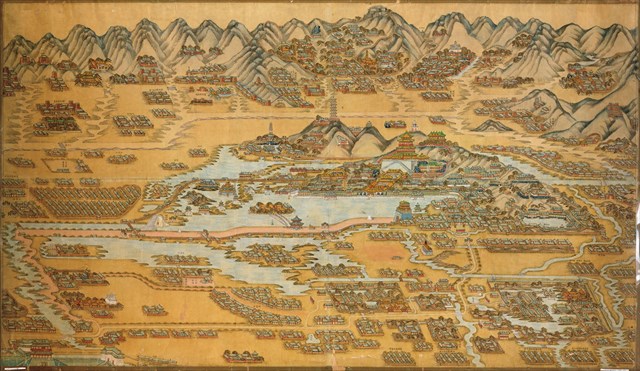
Hall of Jade Ripples lies at the northern corner of Kunming Lake in the Summer Palace. It is noted as having served as the prison of Emperor Guangxu in the late Qing Dynasty.
玉澜堂位于颐和园昆明湖的北岸。在晚清曾作为慈禧软禁清末光绪皇帝的地方。
THE STONE IN THE PALACE 园中石
In China, viewing stones (scholars rocks and spirit stones known by the Chinese as "Gongshi") have been an art of appreciation for over a thousand years.
在中国,鉴赏奇石(一些形状较好专供摆放的奇石会被称为“供石”)是有着千年以上历史的艺术。
This large bluish, glossy stone, known as the Blue Iris Stone, located in the classical gardens at The Summer Palace, Beijing, China, is the largest stone decoration in any Chinese garden. The stone drew the attention of its finders due to it being a large, dark and sleek stone, and was thought to be shaped like a fungus.
坐落在颐和园庭院里的这块海青色的太湖石叫做“青芝岫”,这块石头是所有中国园林石里最大的。它形似灵芝,因其形态巨大、色青、有光泽而吸引人。
THE STONE GEOLOGY 岩石地质学
The Blue Iris Stone is a piece of karst limestone from Beijing’s Fangshan District and was moved to the present location in the garden. The stone is an excellent example of weathered and partially dissolved limestone.
青芝岫是一块采于北京市房山区的石灰岩,后运至此地。这块石头完美地展现了石灰岩的风化侵蚀和部分溶解。
Limestone is a sedimentary rock composed largely of the minerals calcite and aragonite, which are different crystal forms of calcium carbonate (CaCO3). Most limestone is composed of skeletal fragments of marine organisms such as coral, forams and molluscs.
石灰岩是一种沉积岩,主要由方解石和霰石组成,其主要化学成分是不同晶型的碳酸钙 (CaCO3)。大多数石灰岩的形成是源于海洋生物的骨架碎片,如珊瑚、有孔虫和软体动物。
Typically limestone forms by accumulation at the bottom of an ocean or shallow sea. Freshwater limestone can form at the bottom of a lake. After limestone forms the process of weathering occurs. The weathering will mostly occur underground forming caves. Changes in landforms and erosion can bring the limestone to the surface where further Karst weathering can occur.
通常,石灰岩在海洋或浅海底部沉积而成,也可沉积于湖盆底部形成淡水石灰岩。石灰岩形成之后会发生侵蚀,侵蚀作用主要发生于地下形成洞穴。地貌的改变与侵蚀可能使石灰岩露出地表发生进一步风化侵蚀,形成喀斯特地貌(或称岩溶地貌)。

Karst topography occurs when calcium carbonate in limestone is dissolved by weak acids such as carbonic acid. The mild acids find and dissolve susceptible parts of the rock and the resistant sections remain. Weathering and acid action will follow cracks and separate sections of the rock. The karstification of a landscape may result in a variety of large or small features both on the surface and beneath. Underground spectacular caves are formed. On exposed surfaces, small features may include solution flutes, runnels, clints and grikes, collectively called karren or lapiez.
喀斯特地貌(岩溶地貌)是由弱酸(如碳酸)溶蚀石灰岩中的碳酸钙而形成。弱酸会溶蚀掉石灰岩中较松软的部分,并保留下坚硬的部分。风化和溶蚀会沿着石灰岩的裂隙进行,并逐渐将石头分裂开。喀斯特地貌也因此会有地表千沟万壑及地下岩洞遍布的景象。在裸露的表面上,会有一些小特征诸如溶蚀槽痕、细槽、石芽与溶沟,这些均是石灰岩地貌的典型特征。
The Blue Iris Stone shows many of these Karst features. Look along the top of the stone. You can see a cross section of limestone pavement, known as clints and grikes. Look down the sides of the stone and you can see examples of solution flutes and runnels. The stone is a fine specimen of Karst topography. Perhaps those ancient Chinese were looking for an elegant esthetic garden feature but cleverly they selected a worthy scientific sample.
青芝岫上有着许多石灰岩的特征。在它的顶部你可以找到石芽与溶沟,在下半部分又有许多溶蚀槽痕与细槽。这块石头很好地集合了喀斯特地貌的各种特征。或许古人们只是在寻找一块优美的园林石,但他们恰巧选中了一块不错的地质学样本。
LOGGING REQUIREMENTS FOR THIS EARTHCACHE 记录须知
In order to log this Earth Cache you must visit the Summer Palace in Beijing China, there is an entrance fee of around $30 CNY ($20 CNY in winter) to access this cache. You must find the court yard at the listed coordinates and locate the large stone – (you really cannot miss it). You must then answer the following questions to claim a find:
为了登记这个地理宝藏,你必须进入颐和园参观,门票20或30元,因季节而异。你必须找到坐标处的院子和院子里的大石头(你不可能找不到这石头)。你必须正确回答下列问题:
Questions: 问题
1) What was the stone popularly named? 这块石头的俗称是什么?
2) Can you see features in the stone that show it is limestone? 你在这块石头上能找到哪些石灰石的特征?
3) How much of the stone has been dissolved by weathering? Does the weathering form a network or is it discrete dissolution? Does the dissolution follow features in the stone structure? 这块石头的风化侵蚀程度如何?风化是呈网状分布还是分散各处的?侵蚀是否依着石灰石的特征进行?
4) What small features did you observe on the surface of the stone? Why do you think these features have formed? 你在石头表面可以观察到哪些微小特征?你认为这些特征是如何形成的?
There is no need to wait for a confirmation email to log your find. I will read each email to confirm your answers and will contact you if there is a problem. Please do not email photos, just upload them with your log – please use caution though when uploading photos that you do not include the details listed on the information board, any logs showing this will be deleted and you will be asked to resubmit.
在登记前无需等待回信确认,我将仔细阅读每封答案,并将在有问题时联系你。请不要在答案信息中附上图片,可以将图片附到你的记录中。不过请注意不要在图片中包含信息牌,含有此类图片的记录会被删除,你将需要重新登记。
If an email is not received in a timely manner after logging your cache, the log will be deleted. 如果在你登记后的一段时间内我仍未收到你的答案,你的记录将被删除。